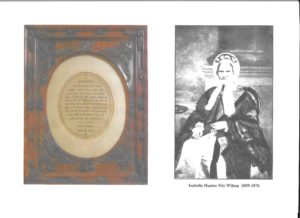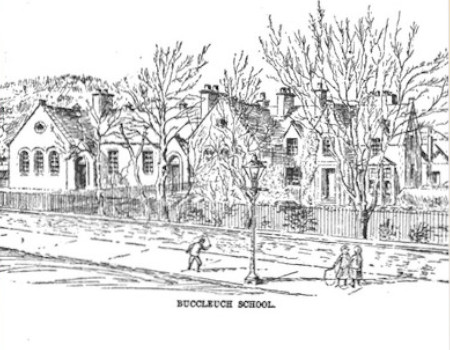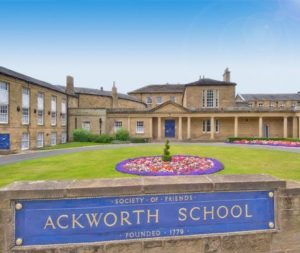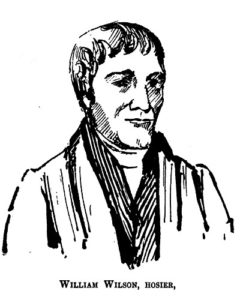The Upbringing of James Wilson, Economist was progressive due to his parents, William and Elizabeth Wilson. His parents were extremely wealthy, being able to delegate child-rearing to local households and being able to send their nine children to a prestigious school, Ackworth in Yorkshire.
William Wilson’s wealth stemmed from his woollen manufacturing business which he established in 1787; in 1804 he took William Watson as his business partner. Between 1812 and 1815 Wilson & Watson became one of the largest hosiers in Scotland producing around 50,000 pairs of hose annually.(1)

The year after James Wilson’s Sister, Isabella embroidered her sampler (pictured above) her Mother, Elizabeth gave birth to her last child, George on the 7th January 1815; eleven days later she died aged 43. Elizabeth gave birth to 15 children in 21 years which must have been exhausting. However, she did not care for her babies herself; being a wealthy woman she was able to place them in the care of local households until they were toddlers.
Note that the image states the incorrect date of birth for Isabella Wilson. There were two daughters named Isabella born to William and Elizabeth Wilson. The first was born 1794-1796. She died in infancy. The second Isabella Wilson was born in 1800 not 1809. She would have been 14 years old when embroidering the sampler not six.
Isabella Wilson is depicted in the sampler mounted in a heavy oak frame above which was discovered in 2016. It reads,
SOLITUDE
It is the hallowed ground which religion hath in every age, chose for her own. There her inspiration is felt, and her secret mysteries elevate the soul. There, falls the tear of contrition, there rises toward heaven the sigh of the heart, there melts the soul with all tenderness of devotion, and pours itself forth before him who made, and him who redeemed it.
Isabel Wilson
Ackworth School
1814
The Regency Era

During the Regency Era most children were educated at home by their parents. There wasn’t a local school to attend for free for all to receive an education as there is today. A wet-nurse or a nanny would have reared the children within the household or attic teaching them how to behave until they became civilized enough to enter the family as little adults. As babies they were wrapped in swaddling clothes so that they wouldn’t cry and when they became a little older they were taught civility.
At the age of eight years old boys would have been shipped off to boarding school. Boarding school departure in Hawick particularly became even younger at the age of six in later generations. It was only after the Regency Era that there came to be a focus on motherhood due to Queen Victoria’s love of family. The trend evolved to “let children be children”.
In the Regency time in England education was mainly for the rich elites although in Regency times Oxford and Cambridge universities awarded degrees for simply answering two questions orally. Also if you read Lord Byron’s poem ‘Thoughts Suggested by a College Examination’ Byron was scathingly satirical about the education he -an aristocrat- received at Harrow school which the young Winston Churchill would later attend. Byron wrote in his poem ‘Happy the Youth Who Scans Euclid’s Axioms with a Critics Ken thought Scarcely Skilled an English Line to Pen…’ In Regency times there was no mass Education programme in England -that did not happen until 1870 -well after the Regency period.
The Scottish Education Act
In Scotland in the 1690’s an Education Act was passed which aimed at providing a school in every parish attached to their established Presbyterian churches. It was never applied universally until 1872 when Scotland had the Education Act of that year based on the English 1870 Education Act which introduced free elementary education aimed at all up to the age of 13.
Hawick Grammar School
The Wilson children were educated at Hawick Grammar School run by Mr. Murray. Also known as Buccleuch after the Duke of Buccleuch. Hawick has always been a very well-run impressive community and had a local school available during the Regency Era in Britain.

Ackworth School
The Wilson children were then sent off to The Society of Friends School in Ackworth, Yorkshire at the age of ten. Searching the lists of Ackworth scholars between 1809 and 1823 we find the Wilson Family: Walter 1809-1810, Katherine 1809-1812, Isabella 1810-1814, William 1812-1815, Elizabeth 1814-1817, Margaret 1814-1817, James 1816-1819, John 1816-1820 and Ann 1819-1823. William Wilson’s business partner, William Watson had two sons, Robert, and William Lindsay, who also attended Ackworth. Other than the Wilsons and Watsons,there was only a handful from Scotland. Going away to Ackworth for four years would be no hardship for the children.

Ackworth was one of eight Quaker schools in England and it was a boarding school. Ackworth School was, and still is, a prestigious boarding school in Yorkshire founded in 1779 by John Fothergill on behalf of The Religious Society of Friends for Quaker boys and girls with the emphasis on quiet reflection and the search for God within oneself and within others, which continues to be their guiding principle. Not only did Wilson send his children to Ackworth but his business partner, Watson also sent his children there. Both Wilson and Watson had a keen interest in education.
After James Wilson’s mother’s death in 1825 his father was left with ten children: Walter, 19:Katherine, 18: Isabella, 15: William, 14: Elizabeth, 13: Margaret, 12: James, 10: John,9: Ann, 7 and George aged 11 days. Five of the fifteen children had died in infancy which was common. It would fall to Isabella and her older Sister Kathrine, who by this time had left Ackworth, to administer the upbringing of James Wilson, Economist.(3)
Though the Wilson children came from a wealthy background, and had the benefit of an excellent education, the upbringing of James Wilson, Economist was poverty stricken when it came to family affection.
After Ackworth, James Wilson then expanded his education as a didactic scholar similar to James Murray, Lexicographer and Hawick Grammar School Headmaster who was also a native of the borders.

In 1817 James’ older brother William was apprenticed to a local hat maker Mr. McCaskie and 5 years later James joined him; shortly afterwards William went to work for Christie & Co., in London. Their Sisters, Isabella and Katherine came with James to run the household and take care of their brothers.
The upbringing of James Wilson, Economist involved multiple influences. He was handed off to strangers, not household servants, to be raised until he could walk. He had siblings who were absent in boarding school. His parents were both absent, his mother being deceased and his father running a successful business. He had a relationship with his older siblings which may not have been so intimate even though they lived together as young adults. Regardless of the cold upbringing of James Wilson, Economist, he was part of a remarkable Hawick family who played a substantial part, not only in the town’s development, but in the world at large and as a result he changed the world at large in his own right.
1 Wilson & Watson separated in 1818.
2 Clifford Gulvin/ “The Hosiery Makers” –p17
3 As per Cynthia Wilson
4 Although this sum is often quoted as yet no record of his estate has been uncovered.
5 Katherine married John Glenny in 1833, and died 1844. In 1875 their son John went into business with his uncle George and established Wilson &Glenny.
6 Taken from the “Life of Sir William Wilson Hunter”

